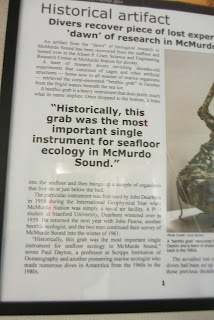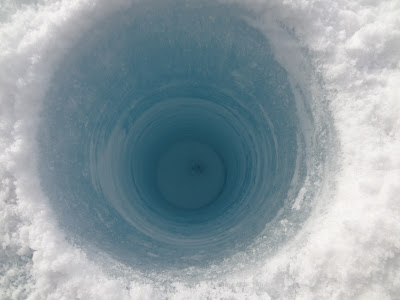Hello All! Sorry for the delay in adding posts - I caught some horrible version of "The Crud" as they call it here and was dreadfully ill for a week or two. It seems that people just pass around diseases here, as you might expect, in close living quarters. I'm now back on my feet and will attempt to catch up on splashing pictures across the internet for your enjoyment.
Here are a few shots of the inside of our lab, as well as from within the larger Crary Building (the main science building here), where we all conduct experiments, hold animals and samples and prepare for field work at all hours of the day and night.
Below are two of four water baths - all held at different temperatures ranging from nearly -2C to 10 C. This is an example of one of the ways in which a heat shock experiment may be conducted. Here, we've obtained liver cells from local fish species and are exposing them to a range of temperatures and time points. The cells have been processed in a manner that allows them to float freely (not attached to one another as you would find within an organ or tissue matrix) in a solution that mimics the nutrients and chemistry normally available within the body of the animal. These cells float within the tubes you see within their faux medium, which in turn, float in the water baths allowing them specific temperature exposure and regulation. These samples will be shipped home for further processing where we'll try to piece together what exactly is happening within the cells upon heat stress exposure. From there, we can extrapolate further to relate environmental and biomedical consequences for both humans and animals.
Here are the other two water baths (total of four):
Below | Floating boat of fishy liver cell samples with a cage-like guard, specially made, so the extreme(ly mild) current won't sweep them away into the inner workings of this contraption.

It looks so simple, but it takes quite a bit of work and many hours to get to this point and many, many hours afterwards in order to obtain the information we are looking for.
The water bath says 8.9 C but it was really just 8.0 C. Tricky, tricky.

When the samples above have reached their destination time point, they are processed and transferred to these vials and stored in the fridge until we can ship them back to our lab at home.

Tiny boxes, with tiny samples that are oh-so-precious, potentially containing large volumes of data waiting to be deciphered.
Chemical shelf shot. Everything must be pre-ordered, specially shipped and stored here until we arrive to make an array of solutions using these ingredients specific to our cause.
Below | A view from the lab window - a helicopter returning from one of the many delivery trips made on flyable days taking people, supplies or both to places either inaccessible or not reasonably accessible by other modes of transportation.
 |
| More samples at different temperatures. |
 |
Another water bath sample boat.
|

As I wander to other parts of Crary, I notice this particular example of how standards for certain things may slip as the season drags on and work becomes exhausting and places to put things seem to become less available. This is an orange in a dirty shoe with dirty socks in the hall which someone will surely thoroughly enjoy in the near future.
And Crary Lab becomes SCRARY:
Below | On another note, this was a fairly recently recovered lost artifact from a data collecting expedition in 1958. It was used to scoop up samples from the sea floor and was lost in the process at one point, only to be rediscovered and set out for display years later (article on right).

BELOW | Here are some fish traps stored outside. We left one submerged at the Jetty
with more hot dog bait and it came up EMPTY - except
for this amazingly colored starfish on the bottom right...



































































